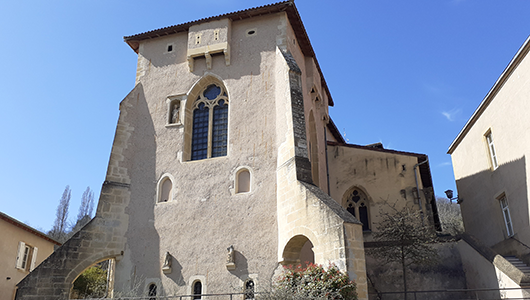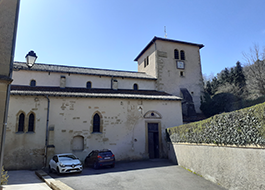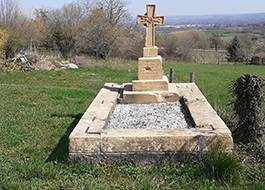Norroy-le-Veneur
Durée visite : 20 min
Moyen : pédestre
Nouroi le Vinour est un village de vignobles. Il appartint au duché de Bar (le bien nommé!) puis des abbayes Saint-Vanne de Verdun et Saint-Vincent de Metz. Un puissant château fort fut édifié par ses seigneurs. Les Messins, en guerre contre René II de Bar et de Lorraine, incendièrent le village en 1490. Les croates alliés des Lorrains l’occupèrent pendant la guerre de Trente Ans.
Nouroi le Vinour is a village of vineyards. It belonged to the Duchy of Bar (the aptly named!) Then to the Saint-Vanne de Verdun and Saint-Vincent de Metz abbeys. A powerful fortified castle was built by its lords. The Messins, at war against René II of Bar and Lorraine, set fire to the village in 1490. The Croatian allies of the Lorrainers occupied it during the Thirty Years’ War.
Nouroi le Vinour ist ein Dorf mit Weinbergen. Es gehörte dem Herzogtum Bar (das treffend benannte!) Dann den Abteien Saint-Vanne de Verdun und Saint-Vincent de Metz. Eine mächtige befestigte Burg wurde von ihren Herren erbaut. Die Messins, die sich im Krieg gegen René II. Von Bar und Lothringen befanden, zündeten das Dorf 1490 an. Die kroatischen Verbündeten der Lorrainer besetzten es während des Dreißigjährigen Krieges.

D’azur au noyer arraché d’or. fruité du champ, à la bordure d’or chargée de douze grappes de raisin d’azur.
Armes parlantes (noyer et grappes de raisin, pour le surnom « le Veneur », déformation de « le vineux »), Couleurs azur et or du duché de Bar, auquel appartenait Norroy (prévôté de Briey).
Azure to the torn off walnut of gold. fruity of the field, with a golden border loaded with twelve bunches of azure grapes.
Talking weapons (walnut and bunches of grapes, for the nickname “the Veneur”, deformation of “the vineux”), Azure and gold colors of the Duchy of Bar, to which Norroy (Provost of Briey) belonged.
Azurblau zu der abgerissenen Walnuss. fruchtig vom Feld, mit einem goldenen Rand, der mit zwölf Trauben azurblauer Trauben beladen ist.
Sprechende Waffen (Walnuss und Weintrauben, für den Spitznamen „der Veneur“, Verformung des „Vineux“), azurblaue und goldene Farben des Herzogtums Bar, zu dem Norroy (Provost of Briey) gehörte.

Les habitants et les habitantes de Norroy-le-Veneur s’appellent les Noissevillois et les Noissevilloises.
The inhabitants of Norroy-le-Veneur are called Noissevillois and Noissevilloises.
Die Einwohner von Norroy-le-Veneur heißen Noissevillois und Noissevilloises.
Les points de visites
Eglise Saint-Pierre;
L’église Saint-Pierre date du XVe siècle. Elle est de style gothique à 3 nefs avec 2 tours romanes fortifiées. Au cours des guerres successives, l’église fut enrichie d’aménagements défensifs : archères, bretèches, échauguettes et canonnières. La tour massive, véritable donjon servait de repli ultime. Sous le chœur se trouve une crypte romane du XIIIe. La Vierge en pierre est du XVe, les vitraux du XVIe. Ils sont dus à Thomas de Clinchamp, Maître Thomas, originaire de la petite paroisse de Clinchamp, dans le diocèse de Toul, a mené l’essentiel de sa carrière à Metz et dans le pays messin, au tout début du XVIe siècle. On lui doit entre autres des verrières du transept nord de la cathédrale (1501) et les très beaux vitraux de l’abside dans l’église de Fêves ( 1505) A Norroy, il a signé le vitrail remarquable du chœur, inscrit depuis 1983 dans l’Inventaire général des monuments et des richesses artistiques de la France. Laurent Maréchal a effectué des travaux de restauration en 1859. Lors de la réfection du chevet en 2007, ce vitrail a été démonté puis transporté à Aiserey, près de Dijon, par l’atelier Parot, qui l’a nettoyé, consolidé et en partie restauré.
Monument aux morts du cimetière.
C’est un édifice impressionnant dû au Souvenir Français. Sa devise figure d’ailleurs sur les écus tenus par les lions. Ces derniers sont placés sur le devant ; ils gardent les tombeaux et rappellent aussi que les hommes se sont battus comme des lions avant de mourir. Le 30 septembre 1925 eut lieu, au milieu d’une affluence considérable, le service funèbre organisé par le Souvenir Français en mémoire des morts des deux dernières guerres. Après la cérémonie religieuse, présidée par l’abbé Lacroix, que les Allemands ont incarcéré comme suspect, la population se rendit en cortège au pied du monument aux morts de la Grande Guerre, érigé dans le cimetière, voisin de l’église, à flanc de coteau. C’est là aussi que reposent, depuis deux ans, les soldats français tombés en 1870 sur le territoire de Norroy.
St. Peter’s Church. The Saint-Pierre church dates from the 15th century. It is in Gothic style with 3 naves with 2 fortified Romanesque towers. During successive wars, the church was enriched with defensive arrangements: archers, breteches, watchtowers and gunboats. The massive tower, a real dungeon, served as the ultimate retreat. Under the choir is a Romanesque crypt from the 13th century. The Virgin in stone is from the 15th century, the stained glass windows from the 16th century. They are due to Thomas de Clinchamp, Maître Thomas, originally from the small parish of Clinchamp, in the diocese of Toul, spent most of his career in Metz and in the Metz region, at the very beginning of the 16th century. We owe him, among other things, the windows of the north transept of the cathedral (1501) and the very beautiful stained glass windows of the apse in the church of Fêves (~ 1505). In Norroy, he signed the remarkable stained-glass window of the choir, registered since 1983 in the General Inventory of Monuments and Artistic Riches of France. Laurent Maréchal carried out restoration work in 1859. During the repair of the bedside in 2007, this stained glass window was dismantled and then transported to Aiserey, near Dijon, by the Parot workshop, which cleaned, consolidated and partly restored.
War memorial in the cemetery.
It is an impressive building due to the Souvenir Français. Its currency appears on the shields held by the lions. These are placed on the front; they guard the tombs and also remind us that men fought like lions before they died. On September 30, 1925, amidst a large crowd, the funeral service organized by the Souvenir Français in memory of the dead of the last two wars took place. After the religious ceremony, chaired by Father Lacroix, whom the Germans imprisoned as a suspect, the population went in procession to the foot of the war memorial, erected in the cemetery, next to the church, on the hillside. This is also where the French soldiers who fell in 1870 in the territory of Norroy have rested for two years.
Peterskirche
Die Saint-Pierre-Kirche stammt aus dem 15. Jahrhundert. Es ist im gotischen Stil mit 3 Schiffen mit 2 befestigten romanischen Türmen. Während aufeinanderfolgender Kriege wurde die Kirche mit Verteidigungsmaßnahmen bereichert: Bogenschützen, Breteches, Wachtürme und Kanonenboote. Der massive Turm, ein echtes Verlies, diente als ultimativer Rückzugsort. Unter dem Chor befindet sich eine romanische Krypta aus dem 13. Jahrhundert. Die Jungfrau in Stein stammt aus dem 15. Jahrhundert, die Buntglasfenster aus dem 16. Jahrhundert. Sie sind Thomas de Clinchamp zu verdanken, Maître Thomas, ursprünglich aus der kleinen Gemeinde Clinchamp in der Diözese Toul, verbrachte den größten Teil seiner Karriere zu Beginn des 16. Jahrhunderts in Metz und in der Region Metz. Wir schulden ihm unter anderem die Fenster des nördlichen Querschiffs der Kathedrale (1501) und die sehr schönen Buntglasfenster der Apsis in der Kirche von Fêves (~ 1505). In Norroy signierte er das bemerkenswerte Buntglasfenster des Chores, das seit 1983 im Allgemeinen Inventar der Denkmäler und künstlerischen Reichtümer Frankreichs eingetragen ist. Laurent Maréchal führte 1859 Restaurierungsarbeiten durch. Während der Reparatur des Bettes im Jahr 2007 wurde dieses Buntglasfenster zerlegt und dann von der Parot-Werkstatt nach Aiserey in der Nähe von Dijon transportiert, die gereinigt, konsolidiert und teilweise restauriert wurde.
Kriegsdenkmal auf dem Friedhof.
Es ist ein beeindruckendes Gebäude aufgrund des Souvenir Français. Seine Währung erscheint auf den Schilden der Löwen. Diese sind auf der Vorderseite platziert; Sie bewachen die Gräber und erinnern uns daran, dass Männer wie Löwen gekämpft haben, bevor sie starben. Am 30. September 1925 fand inmitten einer großen Menschenmenge die vom Souvenir Français zum Gedenken an die Toten der letzten beiden Kriege organisierte Trauerfeier statt. Nach der religiösen Zeremonie unter dem Vorsitz von Pater Lacroix, den die Deutschen als Verdächtigen inhaftierten, ging die Bevölkerung in Prozession zum Fuß des Kriegsdenkmals, das auf dem Friedhof neben der Kirche am Hang errichtet wurde. Hier haben sich auch die französischen Soldaten, die 1870 auf dem Gebiet von Norroy gefallen sind, zwei Jahre lang ausgeruht.
.
A la hauteur du numéro 11 de la Rue de Plesnois se trouve la tombe d’un soldat prussien de la guerre de 1870. Le soldat Kurt Ribbentrop du 5e régiment d’infanterie brandebourgeois a été tué le 7 octobre 1870 lors de la bataille de Ladonchamps pendant le siège de Metz. Le vendredi 7 octobre 1870, les troupes françaises effectuent une sortie à Woippy, au nord de la ville de Metz. Il s’agit d’une opération de fourrage, son but, récupérer un maximum de ravitaillement pour les besoins de la cavalerie prisonnière du siège. Cette bataille, connue sous le nom de Bataille de Ladonchamps, aura pour cadre, pour la rive gauche de la Moselle, un secteur comprenant La Maxe, St Rémy, Bellevue, le château de Ladonchamps, Woippy, Lorry-les-Metz, Vigneulles, Saulny et plus près de nous, Villers les Plesnois, Plesnois et Norroy-le-Veneur. La résistance des troupes allemandes, aidées par une puissante artillerie, fit échouer cette tentative. Les pertes des deux camps s’élevèrent à plus de 3000 hommes (tués, blessés, portés disparus). Ce jour là, une compagnie de partisans d’un régiment de ligne français reçoit une fusillade nourrie venant de tranchées établies et occupées par les allemands entre la ferme Ste-Anne et la route de Norroy-le-Veneur. Les Français se lancent au pas de course sur ces tranchées et les enlèvent en y tuant les Prussiens à coup de baïonnettes. Parmi eux Kurt Eduard Theodor Ribbentrop, qui reçcoit deux coups de baîonnette au torse et à la gorge. Né le 25 septembre 1850 à Deutsch Krone (aujourd’hui Walcz en Pologne), Engagé volontaire d’un an à la 5e compagnie du 5e Brandenburgischen Infanterie-Regiments 48.
At number 11 in the Rue de Plesnoisse is the grave of a Prussian soldier from the War of 1870. The soldier Kurt Ribbentrop of the 5th Brandenburg Infantry Regiment was killed on October 7, 1870 during the Battle of Ladonchamps during the siege of Metz. On Friday October 7, 1870, the French troops carried out an sortie in Woippy, north of the city of Metz. This is a forage operation, its goal, to recover as much supply as possible for the needs of the cavalry trapped in the siege. This battle, known as the Battle of Ladonchamps, will take place for the left bank of the Moselle, an area including La Maxe, St Rémy, Bellevue, the castle of Ladonchamps, Woippy, Lorry-les-Metz, Vigneulles, Saulny and closer to us, Villers les Plesnois, Plesnois and Norroy-le-Veneur. The resistance of the German troops, aided by a powerful artillery, thwarted this attempt. The losses on both sides amounted to more than 3,000 men (killed, wounded, missing). That day, a company of partisans of a French line regiment received a heavy gun battle from established and occupied German trenches between the Ste-Anne farm and the road to Norroy-le-Veneur. The French rushed into these trenches and removed them by killing the Prussians with bayonets. Among them Kurt Eduard Theodor Ribbentrop, who received two bayonets to the chest and throat. Born September 25, 1850 in Deutsch Krone (now Walcz in Poland), Volunteer for one year in the 5 company of the 5 Brandenburgischen Infanterie-Regiments Nr. 48.
In der Rue de Plesnoisse Nr. 11 befindet sich das Grab eines preußischen Soldaten aus dem Krieg von 1870. Der Soldat Kurt Ribbentrop vom 5. brandenburgischen Infanterieregiment wurde am 7. Oktober 1870 während der Schlacht von Ladonchamps während der Belagerung von Metz getötet. Am Freitag, dem 7. Oktober 1870, führten die französischen Truppen in Woippy nördlich der Stadt Metz einen Einsatz durch. Dies ist eine Futteroperation, deren Ziel es ist, so viel Versorgung wie möglich für die Bedürfnisse der in der Belagerung gefangenen Kavallerie wiederzugewinnen. Diese Schlacht, bekannt als die Schlacht von Ladonchamps, findet am linken Ufer der Mosel statt, einem Gebiet, das La Maxe, St. Rémy, Bellevue, die Burg von Ladonchamps, Woippy, Lorry-les-Metz, Vigneulles, Saulny und näher umfasst für uns Villers les Plesnois, Plesnois und Norroy-le-Veneur. Der Widerstand der deutschen Truppen, unterstützt von einer mächtigen Artillerie, vereitelte diesen Versuch. Die Verluste auf beiden Seiten beliefen sich auf mehr als 3.000 Männer (getötet, verwundet, vermisst). An diesem Tag erhielt eine Gruppe von Partisanen eines französischen Linienregiments eine schwere Feuergefechte aus etablierten und besetzten deutschen Schützengräben zwischen der Ste-Anne-Farm und der Straße nach Norroy-le-Veneur. Die Franzosen stürmten in diese Gräben und entfernten sie, indem sie die Preußen mit Bajonetten töteten. Unter ihnen Kurt Eduard Theodor Ribbentrop, der zwei Bajonette an Brust und Rachen erhielt. Geboren am 25. September 1850 in Deutsch Krone (heute Walcz in Polen), Freiwilliger für ein Jahr in der 5 Kompanie der 5 Brandenburgischen Infanterie-Regimenter Nr. 48.
.







